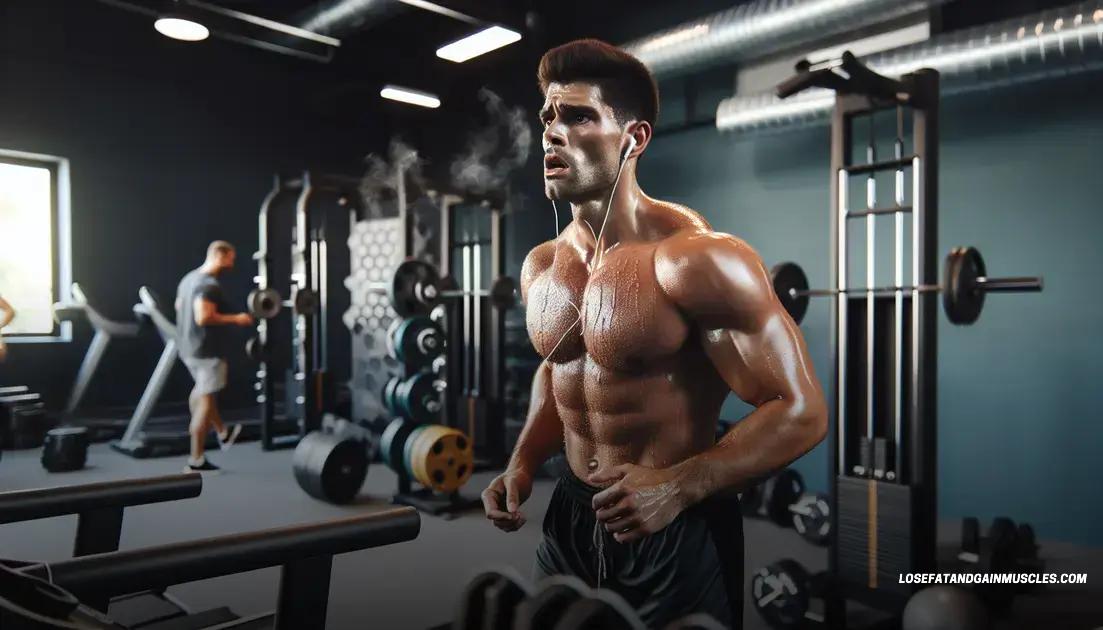Is 30 Minutes of Cardio After Weights Good? Uncover the Truth!
Yes, 30 minutes of cardio after weights is beneficial. It enhances fat loss, boosts cardiovascular health, and promotes muscle recovery when done at the right intensity and duration, making it an effective addition to any fitness routine.
Are you wondering if 30 minutes of cardio after weights is a good practice? Many fitness enthusiasts debate the effectiveness of this routine. Understanding how cardio impacts your weight training results is essential for optimizing your workout strategy. In this article, we will delve into the science behind combining cardio and weightlifting, explore the benefits you can gain, and share tips on how to effectively incorporate this approach into your fitness regimen.
The Science Behind Cardio After Weights
Understanding the science behind cardio after weights helps clarify its potential benefits in a fitness routine. When you perform weight training, your body uses a combination of carbohydrates and fat for energy. After completing your strength exercises, your body enters a state called excess post-exercise oxygen consumption (EPOC), commonly referred to as the “afterburn effect.” During this time, your body continues to burn calories to recover, replenish, and repair muscle tissues.
What Happens to Your Body?
After weight lifting, your muscles are primed for better performance. Engaging in 30 minutes of cardio takes advantage of this state by promoting additional calorie burn. The energy demands of cardio also stimulate blood flow, helping to deliver essential nutrients to your muscles, which promotes recovery.
Fat Oxidation
When you do cardio post-weight training, your body shifts its focus toward fat oxidation. Studies show that this can enhance overall fat loss, particularly when combined with strength training. As your body becomes more efficient at burning fat, you can better achieve your fitness goals.
Cardio Type Matters
The type of cardio you choose can also impact results. Low to moderate-intensity cardio might be beneficial if your goal is to recover while continuing to burn calories. On the other hand, high-intensity interval training (HIIT) could amplify your afterburn effect, further increasing calorie expenditure.
Timing is Key
Lastly, the timing of your cardio workout after strength training matters. Ideally, wait for a short period, around 10-15 minutes, to allow your heart rate to stabilize before beginning your cardio routine. This approach helps maintain optimal performance during both activities.
Benefits of Doing Cardio After Weight Training

Implementing cardio after weight training offers several benefits that can enhance your overall fitness experience. One of the primary advantages is improved fat loss. When you perform cardio after lifting weights, your body is more likely to tap into fat stores for energy, promoting a more significant reduction in body fat.
Enhanced Cardiovascular Health
Regular cardio can benefit your heart and lungs. By doing cardio post-weight training, you’re increasing your heart rate, which helps strengthen the cardiovascular system. Improved cardiovascular health can lead to better performance during workouts and everyday activities.
Increased Caloric Burn
When you complete a weightlifting session, your body continues to burn calories even after the workout. Adding cardio elevates this calorie burn further. This combined approach can help you reach your fitness goals faster, whether that’s losing weight or improving endurance.
Muscle Recovery
For active recovery, low-intensity cardio can increase blood flow to sore muscles, delivering essential nutrients and accelerating the healing process. This allows you to recover more efficiently between workouts, keeping you on track with your fitness routine.
Variety in Your Workout
Incorporating cardio after weights adds variety to your workout, preventing boredom and helping you stay motivated. This change can spice up your routine and keep you engaged, making it easier to stick to your fitness plan.
Improved Mental Health
Engaging in cardio can release endorphins, which improve mood and reduce stress. Pairing cardio with weight training helps maximize these benefits, leading to a holistic improvement in your mental well-being.
How Cardio Affects Muscle Recovery
Cardio can significantly impact muscle recovery after weight training. When you engage in light to moderate-intensity cardio, it promotes blood flow to the muscles. This increased circulation helps deliver important nutrients and oxygen, which are critical for repair and growth.
Flushes Out Toxins
After intense workouts, your muscles accumulate metabolic waste, such as lactic acid. Engaging in light cardio helps flush these toxins out of your system. By doing this, you can reduce muscle soreness and speed up the recovery process.
Reduces Muscle Soreness
Low-intensity cardio acts like an active recovery technique. It keeps your muscles warm and engaged, which can reduce soreness. Some people find that a gentle jog or cycling after weight training makes them feel less stiff the next day.
Enhances Flexibility
Another benefit of cardio post-weight training is improved flexibility. Many cardio activities involve a range of motion that can stretch and lengthen muscles. This can help improve your overall flexibility and decrease the risk of injury.
Aids in Recovery Time
By regularly performing cardio after your strength workouts, you can help shorten recovery times. Quick recovery means you can get back to your next workout feeling refreshed and ready, which can improve your overall fitness gains.
Boosts Overall Endurance
Incorporating cardio into your routine not only helps with recovery but also boosts your overall endurance. Better endurance means you can lift heavier weights and work out longer during your next sessions, leading to increased muscle growth and strength.
Time Management: Cardio and Weight Training

Properly managing your time when integrating cardio and weight training is essential for maximizing results. One way to do this is to plan your workouts in advance. Scheduling specific days for strength training and cardio can help maintain a consistent routine.
Combine Workouts
Combining both cardio and weight training in the same session can be efficient. For instance, you can start with strength training followed by a 30-minute cardio session. This allows you to focus on lifting when your energy levels are highest.
Utilize Supersets
Consider using supersets, where you alternate between weight training and brief bouts of cardio. For example, do a set of weights followed by 1-2 minutes of jumping jacks or a quick sprint. This method keeps the heart rate elevated while efficiently using your workout time.
Choose the Right Duration
Finding the right duration for your workouts can also optimize your time. Aim for about 45 minutes to an hour for a complete session, mixing both cardio and weights. This duration can fit into most schedules, making it easier to stay committed.
Set Clear Goals
Having clear fitness goals helps you prioritize your workouts. If your main goal is strength building, focus more time on weight training and add shorter cardio sessions. Conversely, if fat loss is your goal, increase your cardio sessions accordingly.
Track Progress
Finally, track your workouts to gauge efficiency. Keeping a log can help you see patterns, like which combinations yield the best results. Adjust your schedule based on your findings to continue progressing toward your goals.
Tips for Effective Cardio After Weights
To ensure effective cardio after weights, follow these helpful tips. Start with a warm-up to prepare your body for the upcoming workout. This increases blood flow to your muscles and reduces the risk of injury.
Choose the Right Intensity
Select an appropriate intensity based on your fitness level and goals. If your aim is to burn fat, stick to low to moderate intensity. For improving endurance, incorporate higher intensity intervals.
Focus on Duration
Keep your cardio session around 20 to 30 minutes after weights. This length is sufficient to reap benefits without overexerting yourself. Adjust the duration based on your energy levels and overall training plan.
Hydrate Properly
Stay hydrated before, during, and after your workouts. Proper hydration supports performance and recovery. Drink water to replenish fluids lost during weightlifting and cardio.
Include Variety
Incorporating various forms of cardio, such as running, cycling, or swimming, can keep your workouts interesting and engaging. Variety also helps target different muscle groups and maintains motivation.
Listen to Your Body
Paying attention to how your body feels is crucial for effective cardio training. If you feel fatigued or overly sore, consider adjusting the intensity or duration of your cardio sessions. Always prioritize your health and well-being.
In Summary: Is 30 Minutes of Cardio After Weights Good?
Incorporating 30 minutes of cardio after weights can lead to numerous benefits, including fat loss, improved cardiovascular health, and enhanced muscle recovery.
By focusing on the timing, intensity, and type of cardio, and being mindful of hydration and listening to your body, you can optimize your workouts effectively.
Whether you’re a beginner or a fitness enthusiast, implementing these strategies will not only enhance your performance but also keep your workouts engaging and efficient. Embrace this approach to achieve your fitness goals and maintain a balanced routine.
FAQ – Frequently Asked Questions About Cardio After Weights
Is it beneficial to do cardio after weight training?
Yes, doing cardio after weights can enhance fat loss, improve cardiovascular health, and promote muscle recovery.
How long should my cardio session be after weights?
Aim for about 20 to 30 minutes of cardio after your weight training for optimal results.
What type of cardio is best to do after weight training?
Low to moderate intensity cardio, like jogging, cycling, or brisk walking, is effective for fat loss and recovery.
Do I need to hydrate differently when doing cardio after weights?
Yes, staying hydrated is crucial. Drink water before, during, and after your workouts to replenish fluids lost.
Can I combine cardio and weight training in the same session?
Absolutely! Combining the two can be an effective way to manage time and achieve better results.
How can I prevent muscle soreness when doing cardio after weights?
Incorporate low-intensity cardio for active recovery, and ensure you warm up properly before starting your session.












